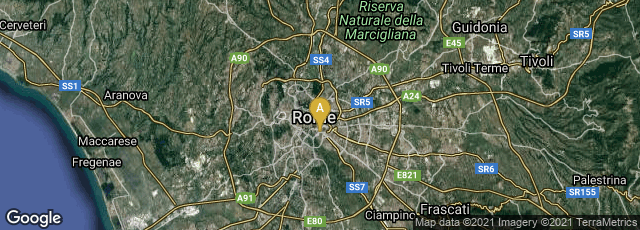

"Excavations carried out at the beginning of the twentieth century in the Capella Sancta Sanctorum, the only surviving part of the ancient Lateran Palace, discovered among the foundations of the chapel the remains of a room of the earliest Lateran library. On one wall was a fresco of a reader, apparently Augustine, seated at a desk, an open codex before him. Beneath it was a legend referring to the writings of the fathers" ( (Gamble, Books and Readers in the Early Church [1999] 162-63).
"The first allusion to a papal library comes from Julius I (337-52), who directed the clergy to settle certain legal matters not in the civil courts in the scrinium sanctum in ecclesia. The use of the singular suggests a central library, whether in the Lateran or in the episcopal church. There is evidence that a little later Damasus I (366-84) rebuilt the basilica of the church of Saint Laurence (San Lorenzo in Prasina) to better house a library. A dedicatory hexameter inscription that once stood over the entrance to the basilica is preserved in a codex of the Vatican library. It reads:
archivis fateor volui nova condere tecta addere
preterea dextra laevaque columnas
quae Damasi teneant proprium per saecula nomen.
"This library, however, was probably not the central ecclesiastical library at Rome, for the Lateran Palace had been the official residence of the pope and the center of ecclesiastical administration since the time of Sylvester I (315-335), and it is more likely that the papal library, including the central archives, was located there.
"Excavations carried out at the beginning of the twentieth century in the Capella Sancta Sanctorum, the only surviving part of the ancient Lateran Palace, discovered among the foundations of the chapel the remains of a room of the earliest Lateran library. On one wall was a fresco of a reader, apparently Augustine, seated at a desk, an open codex before him. Beneath it was a legend referring to the writings of the fathers. Clearly this library contained theological literature, not merely archives. The painting dates from the fifth or early sixth century, but the room was probably a library much earlier. Although the Liber pontificales lists a series of popes, beginning with Celestine I (422-32), who contributed to the growth of the Lateran library, little is known of its scope and contents before the seventh century. The proceedings of the Lateran Council of 649 include an extensive list of books the council requested from the library in order to document the issues, a list that includes a great variety of theological texts, orthodox and heretical, deriving from both the Greek and the Latin church. If this list reflects the actual or approximate holdings of the library, it held an extensive collection of theological literature at least by the middle of the seventh century" (Gamble, Books and Readers in the Early Church [1999] 162-63).